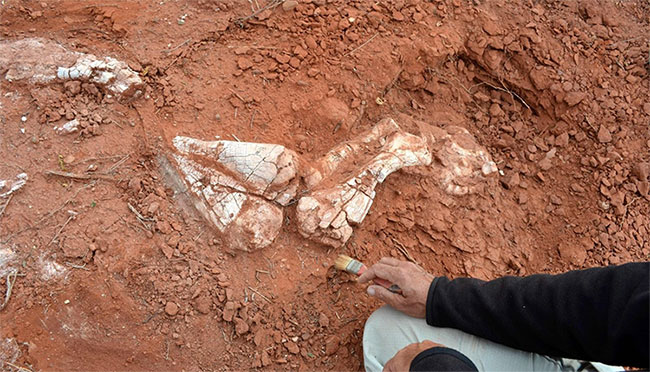Argentina discovered dinosaur fossils living more than 200 million years ago today
On July 9, Argentine archaeologists announced the fossil discovery of the oldest and oldest dinosaur, living more than 200 million years ago in the West.
According to a reporter in Buenos Aires, the fossil was named Ingenia Prima by researchers, three times larger than the fossilized size of the biggest dinosaurs in the Three Gorges.
Fossils were discovered in 2015 in the Balde de Leyes area in the province of San Juan, 1,100km from the capital of Buenos Aires.

Fossils of a giant dinosaur are found in Balde de Leyes, near Marayes, San Juan province, Argentina.(Source: AFP).
Researcher at the San Juan University's Museum of Natural Sciences (IMCN) Cecilia Apaldetti said archaeologists found fossils of some of the neck, tail, front and back fossils of the specimen. on.
According to Mrs. Apaldetti, Ingenia Prima may belong to a group of lizard-legged dinosaurs (Sauropoda) with four legs, herbivorous and recognizable because of its very long neck and tail.
Before finding this specimen, experts say the giant dinosaur lived in the Jurassic period, 180 million years ago. The fossil study co-author, Ricardo Martinez, said Ingenia Prima was at the end of the Tam Diep period, probably 205 million years ago.
The group of experts is conducting research on the Tam Diep century (lasting from about 250-200 million ago), the period of dinosaurs has just begun to appear. The first dinosaurs were small in size, then evolved into giant animals to defend themselves.
According to experts of IMCN, bone fragments of Ingenia Prima show cyclic, seasonal growth and other bone tissue compared to other Sauropoda species, allowing it to grow very quickly.
Ingenia Prima can grow as high as 8-10m, as fossils find a large new dinosaur 6-7m high. This species can grow to about 10 tons, equivalent to 2-3 South African elephants.
The Balde de Leyes archaeological site in San Juan province was first discovered in 2001, and since 2014 Argentine archaeologists have found hundreds of specimens in the area.
- Fossilized a new carnivorous dinosaur up to 6m tall
- The dinosaur tails remain intact in the amber mass of 99 million years
- Detection of 67 million-year-old dinosaur fossils
- 110 million year old dinosaur fossils
- Fossilized 3.5 million years of pangolin in Argentina
- Fossils of dinosaur eggs 70 million years in China
- Australia found fossils tens of millions of years old
- Detecting fossils of 2 new horned dinosaurs
- Discovered a giant dinosaur skeleton that has a lifespan of 70 million years
- Found dinosaur fossils about 75 million years
- Detecting dinosaur footprint 105 million years ago
- Discovered dinosaurs never known in Argentina
 Discovered an ancient centipede fossil 99 million years old
Discovered an ancient centipede fossil 99 million years old Discovered bat-like dinosaurs in China
Discovered bat-like dinosaurs in China Discovered a 200-year-old bronze cannon of the coast
Discovered a 200-year-old bronze cannon of the coast Discover 305 million-year-old spider fossils
Discover 305 million-year-old spider fossils